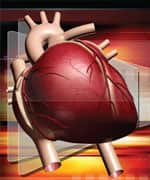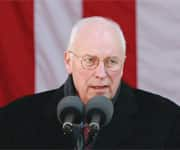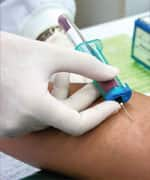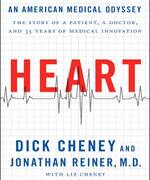Life Extension Magazine®
The story of a patient, a doctor, and 35 years of medical innovation

By Jon Finkel
For those aware of how painfully behind the curve the federal government is when it comes to our nation’s health, it will come as no shock to learn that the White House, in fairly recent history, used to give out free packs of cigarettes emblazoned with the presidential seal. Furthermore, it should come as no surprise that even after the US surgeon general issued his first report on the dangers of smoking, the general public, along with our government officials, ignored the warning and continued to smoke at will.
Vice President Dick Cheney, who spent most of his political career working in or near the White House, is a poster child for how smoking and horrific eating habits can lead to chronic heart disease and, if not for the miracle of modern medicine, death.
In the new book, Heart: An American Medical Odyssey – The story of a patient, a doctor, and 35 years of medical innovation, Cheney chronicles his 40-year battle with heart disease, along with his doctor, Jonathan Reiner, MD. It all began with a near-suicidal diet and smoking problem that took off in the late 1960s. Here is how Cheney describes his lethal lifestyle in his own words:

“My habit really picked up once I got into Washington and was working for Don Rumsfeld, who was a counselor to President Nixon. In those days, just about everyone smoked in meetings, at meals, at home. It was pervasive… Tobacco companies kept the White House stocked with presidential cigarettes that came in gold-trimmed white boxes stamped with the presidential seal. You could also get matches from Air Force One, Marine One and even Camp David… Despite the growing evidence that smoking was bad for your health, we all did it. Even in a meeting in the Oval Office, it wasn’t unusual for most participants to be smoking… By the time I was in my early thirties, I’d developed a heavy smoking habit, my diet was terrible, and I didn’t get nearly enough sleep or exercise. I basically ate whatever anyone put in front of me. Many nights, dinner consisted of high-calorie, high-fat hors d’oeuvres at Washington receptions. Other nights, I’d arrive home late and whip up some eggs and bacon for dinner. Sunday morning meant a trip to the local Krispy Kreme for a dozen doughnuts… I rarely got exercise.”
—Dick Cheney
The book begins with Cheney as a 34-year-old White House chief of staff, who begins and ends each day with the most powerful man in the world, Gerald Ford, the President of the United States.
Like most men in their thirties, Cheney didn’t give much thought to mortality and lived his day-to-day life as if it would never end. The fact that he smoked almost non-stop throughout the day and ate sugar-laden, fatty, nutritionless foods on a regular basis didn’t concern him. Nor did he concern himself with regular doctor visits or blood tests.
Following President Ford’s loss to Jimmy Carter in the 1976 elections, Cheney took some time off and finally had time to go to a doctor for a physical. Following his visit, his doctor told him that given his smoking, cholesterol levels, bad diet, and family history on his mother’s side, he was a prime candidate for a heart attack. He wasn’t even 40 years old.
Cheney didn’t believe him. Instead, he proceeded with his dangerous lifestyle and embarked on a run for Congress. While on a campaign stop in Cheyenne, Cheney woke up at 2 a.m. with a tingling sensation in the two small fingers of his left hand. He woke up his wife and they went to the hospital, where Cheney walked in on his own—then promptly passed out.
When he came to, his room was buzzing with a frenzy of people; he was 37 years old and having a heart attack.

The book goes back and forth between Cheney’s own battle with heart disease and the history of humanity’s struggle with the condition, as told by his doctor, Jonathan Reiner, MD. For instance, Reiner talks about how during World War II, the US Army solicited the assistance of a physiologist, Ancel Keys, to help design a mobile diet for paratroopers. Following the war, Keys, from the University of Minnesota, spent his time trying to figure out why Americans were experiencing such a sharp rise in deaths from cardiac disease. In 1961, in a profile story on him for Time magazine, he recommended the following diet:
Eat less fat meat, fewer eggs, and dairy products. Spend more time on fish, chicken, liver, Canadian bacon, Italian food, Chinese food, supplemented by fresh fruits, vegetables, and casseroles.
While he had a few things right, he had almost everything else wrong—and this was considered a cutting-edge recommendation for his time!
In 1984, Cheney had his second heart attack while working on Capitol Hill. Even though his first heart attack prompted him to quit smoking, he considered the second one a “true wake up call,” as his lifestyle in terms of his hours worked, the stress he endured, and his new hobbies of playing tennis, hiking, and skiing pushed his heart to the limit. Unfortunately for his health, as his heart conditioned worsened, his responsibilities in Washington continued to increase. At this time, Cheney began to develop a relationship with his physician, who would monitor his activities and allow him to fully participate in his life and job.
Of course, the best-laid plans often fall apart, and the bill of Cheney’s early abuse to his body, along with his genes, came due for a third time in 1988, when he awoke once again with chest pain and was brought to George Washington University Hospital.
When he arrived in the emergency room his blood pressure was 115/70, and his pulse was 64, which were both considered normal. However, his EKG showed signs of a new MI and after a series of tests a new clot was discovered blocking the right coronary artery, confirming a third heart attack in ten years.
Further tests showed that Cheney’s coronary artery disease was progressing, prompting his doctor to advise bypass surgery. Cheney says that at this time, his quality of life was greatly affected and he was having difficulty carrying his luggage through airports due to such decreased stamina.
“Having open heart surgery wasn’t something I looked forward to, but if I wanted to continue my career in Congress and continue my skiing and pack trips in Wyoming and all of the other activities I loved, it was necessary,” he says, reflecting on his thoughts.
The surgery was successful and four months later he was back to skiing at Vail and Beaver Creek.
Vice President Cheney’s fourth heart attack occurred in 2000 and ultimately became famous for the physician’s description of how insignificant the cardiac event was in his press conference:
We have biochemical markers that enable us to determine whether or not there has been any damage at all to the heart muscle. And over the last several years…we’ve had some new tools, much more sensitive markers which weren’t available several years ago which enable us to detect extremely small levels of heart muscle damage… Two or three years ago we would simply—based on the biochemical data available then—we would simply have classified the event as just angina.

Nevertheless, it was Cheney’s fourth heart attack in less than two decades, and it signaled an increasingly serious escalation of his heart problems. As the book is about medical innovation and the evolution of cardiac care, the following chapters are filled with information about the history of several heart devices, as well as the men who invented them. With each device, for instance, a stent, we learn how it was used in the care of Vice President Cheney, all the way up to when an ICD (implantable cardioverter defibrillator) saved his life in 2009 by rapidly pacing his heart during a V Fib event.
This reprieve, however, was only temporary, as Cheney would remarkably suffer a fifth heart attack in 2010. The story behind each of these events is relatable on a medical level but also holds special interest in terms of how it is handled when the man suffering the event is the Vice President.
Following his fifth minor heart attack, Cheney continued to try and keep a normal schedule, but he was experiencing labored breathing and exhaustion on a regular basis, and by June of 2010 he was approaching end-stage heart failure. He could no longer walk down the driveway to get his newspaper or climb the stairs to get to the second floor of his house. He describes waking up in the morning with barely enough energy to make it to a large chair, just to fall asleep again. After dozens of heart procedures and nearly countless episodes, the Vice President began to feel like his time was almost up, as they had used nearly every bit of technology and all the medical procedures available for dealing with his disease. At this point, there were only two options left. The first was a heart transplant, which, with an average waiting period of 12 months, wasn’t a possibility due to his worsening condition. The second was an LVAD, or left ventricular assist device, which is ultimately what Cheney opted for.
Cheney’s five-week hospital stay for the LVAD surgery was the “toughest” procedure he’d undergone, and the details should be required reading for those who feel they don’t need to take care of their heart. Essentially, with the exception of breathing, following the LVAD procedure, there was no bodily function he could perform without assistance.

His recovery from the procedure was painstaking and it was especially so when you consider that the purpose of the device was to allow him to live long enough for an even more serious procedure: a heart transplant.
Altogether Cheney would spend 20 months on the LVAD pump. Then, on March 23, 2012, Cheney got the call that the transplant team had a new heart for him. Later the next day, Cheney’s badly diseased heart was removed and he was given a new one, almost 30 years after his original heart began deteriorating.

Item # 33866
Following the procedure, Cheney was on a respirator for a few hours and says he only experienced minor discomfort. Three days after surgery, he was out of bed and walking around the hospital; nine days later he was discharged. Other than taking antirejection medications to suppress his immune system so that it doesn’t reject his new heart, his recovery has been trouble free.
He has returned to working on his property in Wyoming, although he covers his skin and wears lots of sun block to prevent skin cancer, which is a risk due to his compromised immune system. As with most heart transplant patients, Cheney has to monitor his weight and his diet. While his new heart has worked out well so far, there is no substitute for vigorously taking care of the one you have.
For those interested in the evolution of heart care and the procedures available to prolong the life of an aging human with heart disease, this book will provide valuable information and an interesting history of cardiac medicine and technology.
If you have any questions on the scientific content of this article, please call a Life Extension® Health Advisor at 1-866-864-3027.

